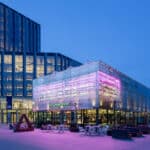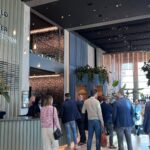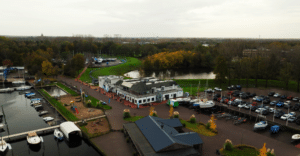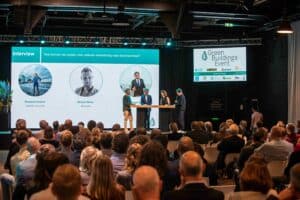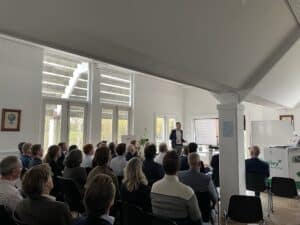
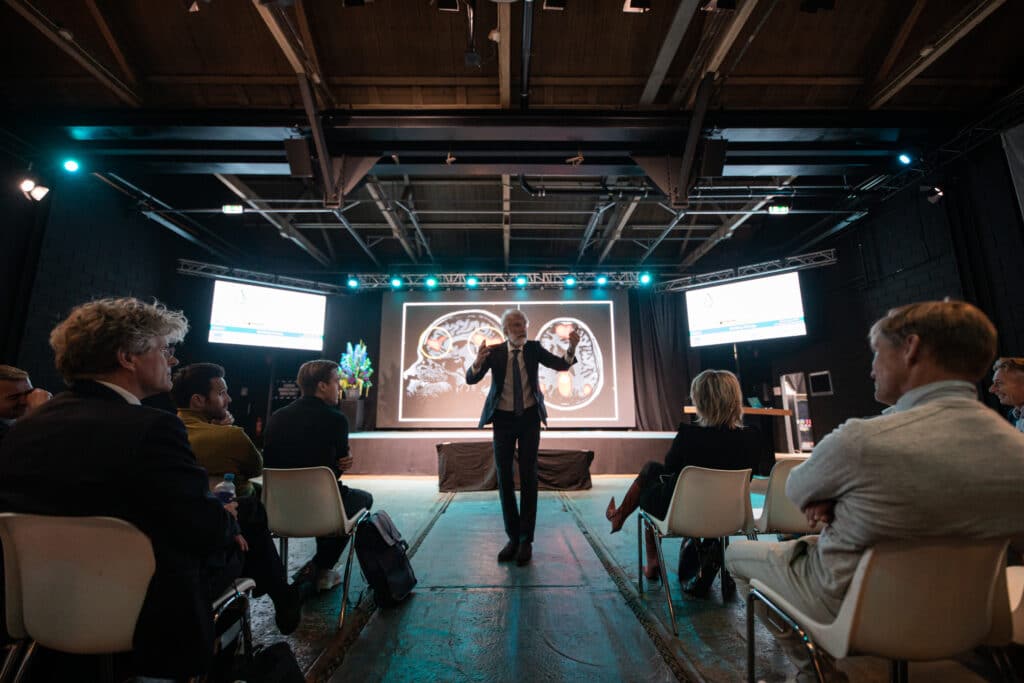
Green Buildings Event 2021: ‘Radical change through innovation, knowledge sharing and nerve!’
It is abundantly clear: a change must take place if the Paris climate targets are to be met. There is a lot to do and not enough time. How do we make the necessary shift towards sustainability and what inspiration and innovation do we find along the way? Based on the theme ‘Building Change’, the Green Buildings Event provided an insight into possible solutions.
Curious about an impression of the day? Watch the aftermovie of the Green Buildings Event.
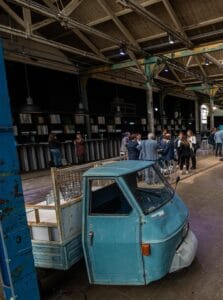
It had been a while since hundreds of professionals could enjoy a physical edition of the Green Buildings Event. ‘The energy transition is swimming against the tide’, it was said two years ago in a packed auditorium at ‘t Spant in Bussum. This year, it was the turn of industrial event venue De Rijtuigenloods in Amersfoort to host the latest edition. The programme promised a varied day, with a wide variety of speakers from different, sometimes unexpected, backgrounds.
With ‘Building Change’ as the main theme, some 300 participants were confronted with the hard facts: the built environment makes the largest negative contribution when it comes to the depletion of resources. In addition, our buildings are responsible for a considerable amount of greenhouse gas emissions. So the construction and real estate sector has got to get down to work, but are we taking enough steps? “Increased sustainability is not progressing fast enough”, CFP director Bram Adema was quick to point out. “Today, let’s be inspired by radical change-makers. In terms of innovation, sustainable energy and breaking down barriers.” Chair of the day Twan Huys set the ball rolling together with Roebyem Anders, Dennis Storm and Mark van Baal. They showed how they – each from their own individual position – are setting the pace for sustainability.
Everyone can contribute to sustainability
Roebyem Anders, for example, is working hard with Sungevity to make solar energy accessible to everyone. Not only in the area of housing, but also in schools, for example, with an initiative such as the School Roof Revolution. Yet, according to her, things are not moving fast enough. “Only one in eight households currently has solar panels and 90% of the roofs on industrial estates are still bare. There is much work to be done.” According to her, radical change comes naturally if you make sustainability simple and fun for everyone. “We try to contribute with our initiatives, for example for schools. We need to get to a situation where people are asking themselves: ‘What’s wrong with you, your roof is still bare!’.”
Initiating change yourself
Mark van Baal of Follow This asked Shell a similar critical question. In 2015, he got this multinational ‘talking’ about accelerating sustainability. First he was told ‘You are far too early’. “Apparently they couldn’t think of anything better than to return EUR 8 billion to shareholders. That is incredible, because there is still so much to be done in terms of sustainability. The pension funds are not making the right decisions now, and I am opposing that.” Van Baal believes that the frontrunners present at the Green Buildings Event 2021 can and should make a difference. “You, the Dutch construction industry, will be making investment decisions tomorrow that could cost us dearly in the future. For new buildings, choose only energy-neutral and, for existing buildings, proceed step by step. But do it while you still can.” Anders added: “We also miss narratives about how sustainability is possible. So share knowledge about working without mains gas and energy-neutral building and initiate change yourself.”
“It all depends on personal leadership and intrinsic motivation.“
– Mark van Baal, Follow This
Dennis Storm also pointed out that a lot has to be done in a short time and that we ourselves are responsible for the speed with which we are becoming more sustainable. As a minimalist, he was critical of travel movements. “You really can’t justify that any more. I decided to stop travelling and use resources differently. That means buying second-hand clothes and no longer plundering the earth.” He challenged others to follow him in this thinking: “Why wouldn’t you want a minimalist life? Shouldn’t that just become the new standard?”
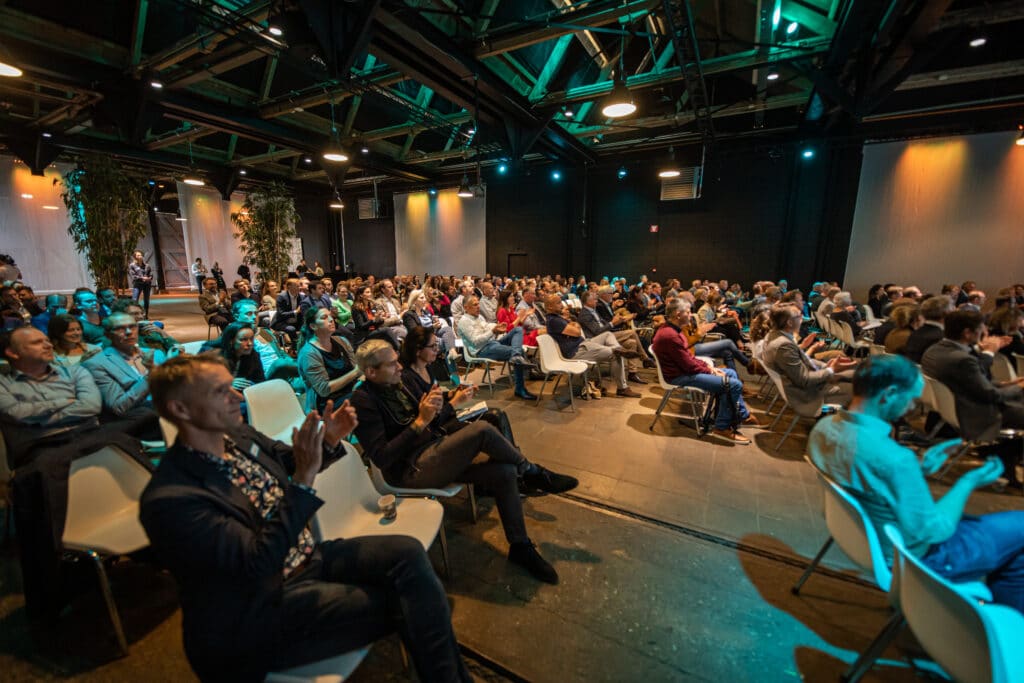
It’s all about contact
Everyone seems to agree: nobody is against sustainability, but only a few go beyond the standard. In the first place, economic, social and technological opportunities must be clear. Even after that, it can be difficult to get the peloton to follow. How do you get stubborn people to change their minds? Marcel van de Ven, a specialist in negotiations, told us about this. “Get to know the people you are doing business with. It’s all about striking the right note. Invest in connection, also with businesses and even if it may not bring you much reward at first sight.” ‘Connection’ seems simple enough, but according to Van de Ven it is anything but. “Listening is the most important thing. That’s when you really connect.”
Looking ahead
What barriers does the construction and real estate sector need to break down? A panel discussion with Lizzy Butink (asr real estate), Rick Bruins (Remeha) and Bram Adema revealed what we need to focus on in the period ahead. Bruins: “We often make things too difficult for ourselves. For example, by overanalysing sustainability or waiting for innovation. The technological solutions are already there, so the important thing is to just start making them sustainable.” He sees a changing role for his organisation, which helps to initiate this movement: “We try to get involved as early as possible in order to think about the different routes to Rome. We see ourselves more and more as an advisory party that contributes constructively regarding the possible impact as a result of sustainability.” Butink sees an opportunity in overturning existing structures. “Because the cycles of natural replacement take too long, sustainability is not happening fast enough. That has to change.” When the time comes for large-scale maintenance or renovation, comprehensive sustainability is important. “Look far ahead and invest in the future so that you add value in different areas, such as health.”
Dragons’ Den: the final judgement
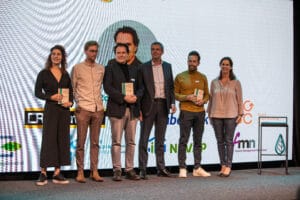
Then it was time for the Dragons’ Den final. Earlier, Sun Tank, NatureConnect and Spotr.ai beat no fewer than 18 pitches in a blistering preliminary round and emerged as finalists. A professional jury consisting of chair Roel van de Bilt (Rabobank), Annemarie van Gaal (KRO’s Dragons’ Den) and Jouri Schoemaker (Dutch pitching champion) – gave the final verdict: Sun Tank won the Dragons’ Den final by a majority of votes. The Sun Tank is a modular and constructible building element in which energy can be stored. According to pitcher Roland Kreugel, Sun Tank can save between 82% and 100% on energy bills, as both thermal and electrical energy can be stored in buffer tanks under the floor, in the wall or on the roof.
Changing together
The thought of creating change and taking different paths to do so naturally has an effect on our brain. All the more reason to study that neurological pathway and find out how our brain is able to achieve large-scale change. Professor of neuropsychology Erik Scherder looked into this. “Resistance to change is only logical. The fewer changes we make, the less energy it takes. To initiate change, we have to be uninhibited and make an effort to accelerate ourselves and others.” When we successfully make that change, our body produces the substance dopamine. “That is the reward that goes to all the cores. If your brain is giving you the feeling that you and your organisation are stuck doing things the same way time and again, then it’s time for change.” According to Scherder, it is important to heed a positively stimulating environment. “You need an environment that challenges you. So surround yourself with people who want to change with you.”

Written by Marvin van Kempen, Duurzaam Gebouwd

